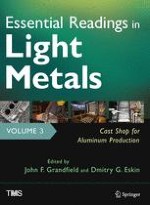2016 | OriginalPaper | Buchkapitel
Prediction of Hot Tears in DC-Cast Aluminum Billets
verfasst von : J.-M. Drezet, M. Rappaz
Erschienen in: Essential Readings in Light Metals
Verlag: Springer International Publishing
Aktivieren Sie unsere intelligente Suche, um passende Fachinhalte oder Patente zu finden.
Wählen Sie Textabschnitte aus um mit Künstlicher Intelligenz passenden Patente zu finden. powered by
Markieren Sie Textabschnitte, um KI-gestützt weitere passende Inhalte zu finden. powered by
The appearance of hot tears, a very severe defect in castings, is a major limitation to the production of foundry cast parts and to the productivity of continuous casting processes such as the direct chill casting of aluminum alloys. As an example, the casting speed of the direct chill casting of billets is limited for some aluminum alloys because of their high propensity to develop hot tears, which initiate at non-zero liquid fraction at the bottom of the sump.In order to predict the occurrence of hot tears in solidifying parts, a hot tearing criterion based on the ability of the interdendritic flow of liquid to compensate for the thermally-induced deformation of the roots of the dendrites has been recently derived by Rappaz, Drezet and Gremaud [1]. Based upon a mass balance performed over the liquid and solid phases, this criterion accounts for the deformation of the solid skeleton and for feeding of the interdendritic liquid: it allows for the calculation of the pressure drop in the liquid at the roots of the dendrites. If the pressure falls below a given cavitation pressure, hot tears will initiate and propagate.The present paper gives a summary of the main features and assumptions of the new hot tearing criterion. The equations defining the hot cracking sensitivity index in the particular case of a uniform thermally-induced deformation rate in the mushy zone are presented. The influence of the solidification path for the AA6063 alloy is studied.This criterion has been implemented in a FEM thermo-mechanical model of the DC casting of round billets of aluminum alloys. It is shown that the bottom of the sump is more sensitive to hot tearing than the primary cooling zone and that the casting speed has a large influence on the appearance of hot tears, as observed in production. Finally, it is shown that the criterion developed by Clyne and Davies [2], when applied to the same conditions, yields the opposite trend.
